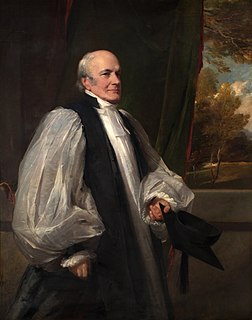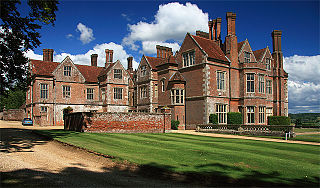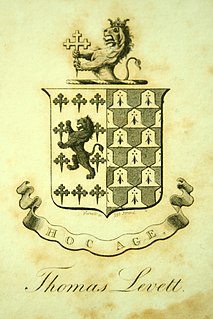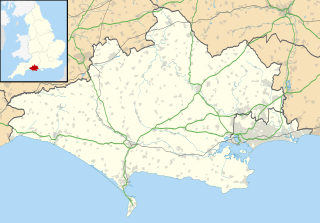
Charles Thomas Longley was a bishop in the Church of England. He served as Bishop of Ripon, Bishop of Durham, Archbishop of York and Archbishop of Canterbury from 1862 until his death.

Hinton Admiral railway station is a station serving the villages of Bransgore and Hinton and the town of Highcliffe on the Hampshire/Dorset border in southern England. It is 101 miles 5 chains (162.6 km) down the line from London Waterloo.

Breamore House is an Elizabethan manor house noted for its fine collection of paintings and furniture and situated NW of Breamore village, north of Fordingbridge, Hampshire, England. Though it remains in private hands, it is open to visitors from April to October.

Flintham is an English village and civil parish in Nottinghamshire, some seven miles from Newark-on-Trent, opposite RAF Syerston on the A46. Its population was 597 at the 2011 Census and estimated at 586 in 2019. The village name was taken by the Ham class minesweeper HMS Flintham.

Sir Peter Mews, of Hinton Admiral, was an English politician who sat in the House of Commons from 1710 to 1726.
The Tapps, later Tapps-Gervis, later Tapps-Gervis-Meyrick Baronetcy, of Hinton Admiral in the County of Hampshire, is a title in the Baronetage of Great Britain. It was created on 28 July 1791 for the landowner and developer George Tapps. The second Baronet sat as Member of Parliament for New Romney and Christchurch. He assumed in 1835 the additional surname of Gervis. The third Baronet was high sheriff of Anglesey in 1878. He assumed in 1876 by Royal licence the additional surname of Meyrick according to the will of Owen Fuller Meyrick, a relative on his mother's side, from whom he inherited the Bodorgan estate on the Isle of Anglesey. The fourth Baronet was high sheriff of Hampshire in 1900. The fifth Baronet was high sheriff of Anglesey in 1939.

Sir George Ivison Tapps, 1st Baronet was a British landowner and developer involved in the founding of Bournemouth.

Hinton Admiral is the estate and ancestral home of the Tapps-Gervis-Meyrick family and located in the settlement of Hinton, near Bransgore in Hampshire, England. It is a Grade I Listed building.

The History of Bournemouth and human settlement in the surrounding area goes back for thousands of years.

Sir George William Tapps-Gervis, 2nd Baronet was a British politician and land developer.
Sir George Eliott Meyrick Tapps-Gervis-Meyrick, 3rd Baronet was a land owner and developer, and served as High Sheriff of Anglesey in 1878.

Wychnor Hall is Grade II Listed early 18th-century country house near Burton on Trent, Staffordshire, formerly owned by the Levett Family. The hall has been converted to a Country Club.

Levett is a surname of Anglo-Norman origin, deriving from that of the French de Livet, which is held particularly by families and individuals resident in England and British Commonwealth territories.

Mudeford is a harbourside and beachside parish based on a former fishing village in the east of Christchurch, Dorset, England, fronting water on two sides: Christchurch Harbour and the sands of Avon Beach.

Sir Richard Levett, Sheriff, Alderman and Lord Mayor of London, was one of the first directors of the Bank of England, an adventurer with the London East India Company and the proprietor of the trading firm Sir Richard Levett & Company. He had homes at Kew and in London's Cripplegate, close by the Haberdashers Hall. A pioneering British merchant and politician, he counted among his friends and acquaintances Samuel Pepys, Robert Blackborne, John Houblon, physician to the Royal Family and son-in-law Sir Edward Hulse, Lord Mayor Sir William Gore, his brother-in-law Chief Justice Sir John Holt, Robert Hooke, Sir Owen Buckingham, Sir Charles Eyre and others.

Captain Egerton Bagot Byrd Levett-Scrivener (1857-1954) was a Royal Navy Flag Lieutenant and aide to Vice Admiral George Willes in the Far East. He was later promoted to Captain, and following his retirement became Bursar of Keble College, University of Oxford. Born Egerton Levett, he changed his name to Levett-Scrivener on an inheritance from his aunt of Scrivener family properties at Sibton Abbey, Suffolk, which he later managed. Levett was married to the daughter of English diplomat and ambassador Sir Harry Smith Parkes.

Bodorgan Hall is a country house and estate located in the hamlet of Bodorgan, Anglesey, Wales, situated near the Irish Sea in the southwestern part of the island. The hall is the seat of the Meyricks, and is the largest estate on Anglesey. The hall is the home of Sir George Meyrick and his wife, Lady Jean Tapps Gervis Meyrick who is the niece of the Duke of Buccleuch.
Joseph Hanks (1725–1793) was the great-grandfather of United States President Abraham Lincoln. It is generally accepted that Joseph was the father of Lucy Hanks, the mother of Nancy Hanks Lincoln. There is also a theory that Joseph and his wife, Ann ("Nannie"), had a son named James who married Lucy Shipley, sired Nancy Hanks, but died before Lucy and Nancy came to Kentucky.

William Henry Poulett, 6th Earl Poulett was an English peer, landowner, army officer, and racehorse owner. In the House of Lords he was a Conservative.

St. Luke's Church is a Church of England parish church in Burton, Dorset, England. It was designed by Benjamin Ferrey & Son and opened in 1875. The church has been a Grade II listed building since 1976. Historic England describe St Luke's as a "pleasing Victorian Gothic village church", with "a careful use of materials", "good Victorian fittings" and "a sense of honest simplicity".



















